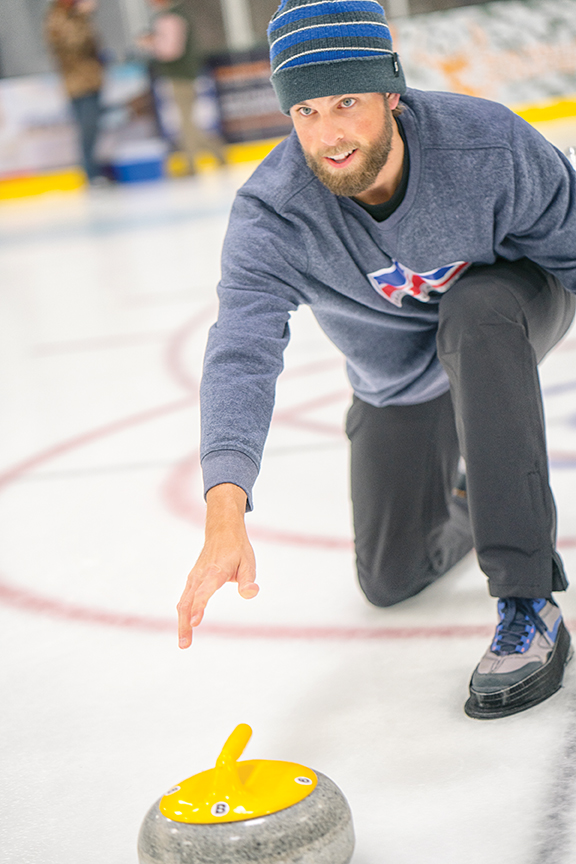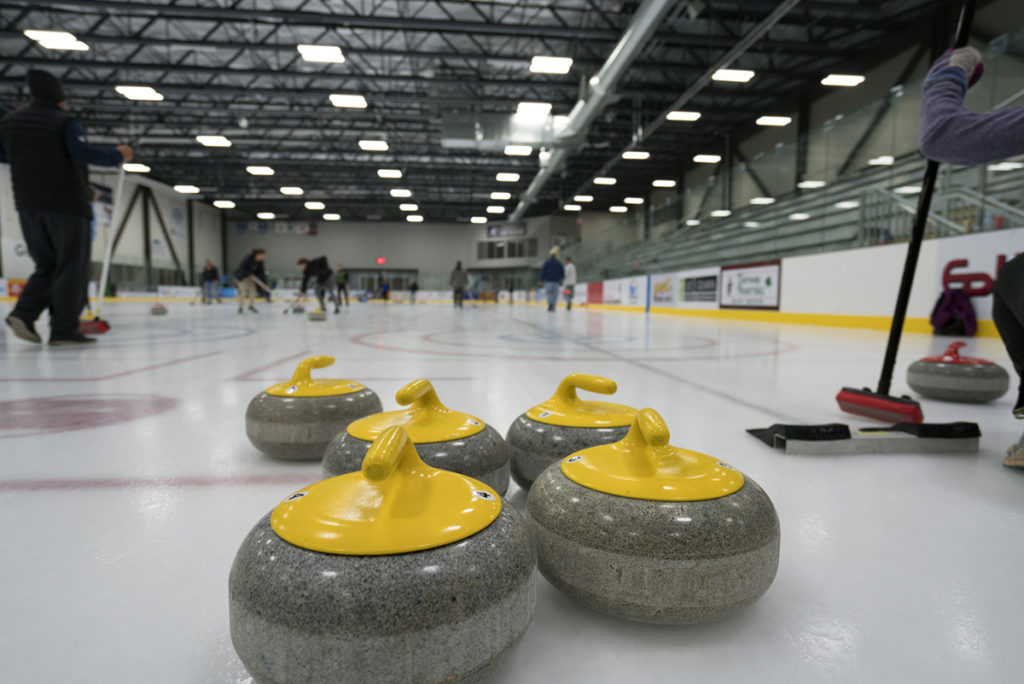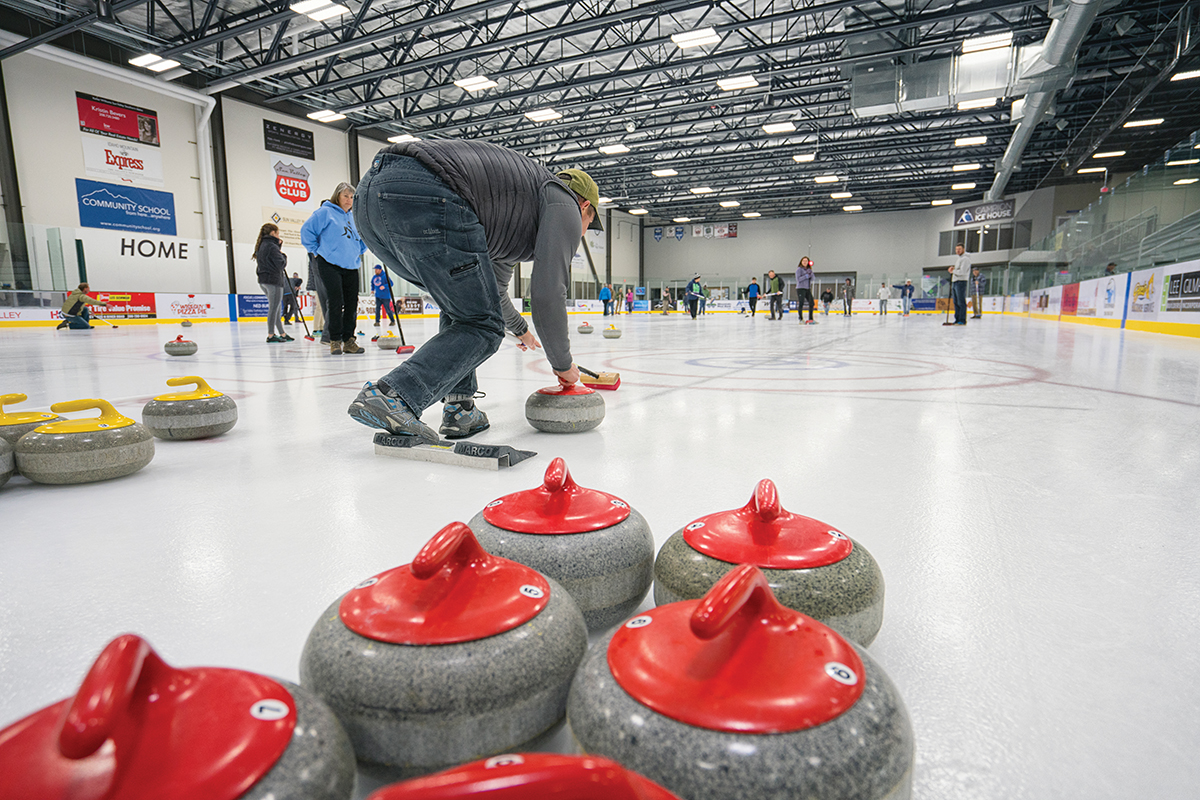The winter diversion of curling is like bowling, but played on ice and without the pins. It’s the game with “the rocks and the sweeping and the yelling,” according to a two-minute video introduction produced for USA Curling.
As with bowling, beer is still on tap outside of the Olympic arena. (Canadians have been into the game for well over a century and a half, so, there must be beer on the social pitches.) A plaque on the rink at the New Caledonian Curling Club in Nova Scotia says the club was established in 1850, some three hundred years after the game emerged in Scotland. Since the founding of clubs like the one in New Caledonia, stone for curling has been hewn by private mining right from the island of Ailsa Craig, Scotland’s inhospitable North Sea source of “blue hone” granite some 40 rough nautical miles out.
Today, with a little help from people like a curling stone distributor in North Dakota, a half hour drive from Winnipeg, Manitoba, the fun is growing south of the border like Kudzu, but with a less invasive, more inclusive feel than the plant and it’s reaching all corners of the country.
In Blaine County, interest in the sport began a few years ago as homemade fun bred from YouTube videos, kitchen bowls, some concrete, plumbing pipe and construction adhesive. It’s a game played with 16 heavy orbs of stone, which are about 42 pounds per unit. (Two teams of four compete at a time and each player has two stones.) Unlike bowling balls, the objects have handles instead of finger holes and slide rather than roll. They, too, carry the mysterious, strategic physics created by adding spin to a forward-moving object over a flat, smooth surface. It’s all a little “Bend It Like Beckham” with lots of yelling and sweeping to burnish the ice along a trajectory toward the “house,” a 12-foot target at either end of nearly 150-foot-long lanes, also called sheets. Players slide the stones, then eke out distance and influence direction with the sweeping brushes. The captain, or “skip” of each four-person team directs the ice brushing with each shot; thus the yelling as each of the stones per “end” are ushered toward the target as “guard,” “draw,” or “take-out” shots. The team with the stone closest to the bullseye scores the points per round, which is called an end.

Brett Buxton sends a stone down the ice. Photo by Todd Meier.
Bowlers who have played at indoor bowling lanes know the feeling that comes with achieving the perfect roll and English that can produce a thrilling strike. That feeling is replicated on ice in the game that is like shuffleboard, boules or bocce, but with a different mass and substrate. As the name indicates, the main strategy is perfecting the curve.
In his winter free time, longtime Blaine County school teacher James Foster for years has helped to set up and maintain the outdoor ice in Roberta McKercher Park, the place where his curling interest was sparked. (Full disclosure: Foster let me take the Zamboni for a spin when I found him cleaning the ice late one winter night. With a bit of a lead-foot, I may have made Foster a little nervous driving a little too fast through the curves of my lap, but the ice was smoother, in any case.)
Today, thanks to the advent of the beneficent Campion Ice House and Foster’s inspiration with his friend Glenn Lyndsley to create homemade curling stones, there’s an explosion of local interest in the sport. Even refurbished, curling stones cut from granite can sell for $5,000 for a set, so there’s a significant commitment to organizing a league. The fun derived from Foster and Lyndsley’s homemade stones a few years ago inspired a few locals from all walks of life to make the game more official here.
The unveiling of the sport most locals only know from televised Olympics has engendered organized, fun-loving competition. Born out of duct tape inspiration, the new league is a heartwarming example of simple, old-world community building that starts by word of mouth.
“(We) decided to make some stones to use on the outdoor rink in Hailey,” Foster said. “That began the demand for the four lanes we have this season at the Campion Ice House.”
Foster says some of the joy in the sport for him is that teams in the league represent all ages and all demographics of the Wood River Valley.
“We have many folks who have never skated before to one of the Suns players,” he added.
The organizers consulted various websites for rules and suggestions, including USA Curling. The interest is so great that the 24 teams competing on four lanes at the ice house this year filled immediately with even more names on the waiting list.
“We make the schedule. Most people come in, play their game for the night and go home,” said volunteer organizer Sarah Benson. “We keep track of the score, and there will be playoffs at the end of the season.”
The season started in the early fall and goes through the beginning of the year.
Benson said most people playing the novel game are beginners. It’s fun even for non-skaters since that’s not a required skill for curling.
“It’s an adult league and we have all ages from 20 into the 70s,” Benson said. “It’s another sport for winter and an opportunity to get on the ice. I’d equate it to a bowling league.”

The Science and Art of the Rocks
All curling stones are old and rare. Hewn from million-year-old granite, the stone for most curling rock comes essentially from only two quarries, Scotland’s Ailsa Craig, which is now also a wildlife sanctuary in the North Sea and restricts mining on the island to a week of rock collecting by hand each year. The second source of so-called micro-granite is the Trefor Granite Quarry in Wales. Ailsa Craig produces what’s called blue hone and Ailsa Craig common green, two types of granite used in making curling stones. Blue hone is essentially harder and prevents the water penetration that can erode stone by freezing. Ailsa Craig common green is considered a lesser quality granite, but in curling rock it has better shock absorption, which is important to reduce chipping since stones in competition often collide at high velocity. Historically curling stones were made from blue hone. However, since 2009, stones for Olympic competition have been cut and refurbished so that the main part of the stone is common green for shock absorption and the running surface is cut so a layer of hard blue hone can be affixed with epoxy. The density of blue hone reduces friction on the ice.
“Some of these stones have been used for 100 years,” said North Dakota curling supplier George Phillips who delivered the 16 old stones for curling at Campion. Phillips added that in addition to the aesthetic beauty of the stones his favorite part of his life-long commitment to the sport, including professional competition and refereeing, is the social engagement of amateur play and talking about the refinements like the integration of different granite for each stone. “You use the best of two worlds.”
Today, stones reformed in this way are made with computer-driven saws, drills and polishers that are anchored to a concrete slab to prevent any vibration from causing imperfections. The system is much like 3D-printer technology, Phillips said, explaining that stone uniformity is key because it levels the playing field and truly shows the curling skill of each player.
The Canadian native lives in North Dakota, also James Foster’s home state, and he’s seeing the sport of his great passion taking off in the U.S., even in warmer states like Florida and Texas. In the Twin Cities in Minnesota there will soon be enough curling sheets in the metro area to host a 500 team bonspiel, as a large curling tournament is called.
“I was part of the curling centennial in Manitoba, Canada. Manitoba once had 126 sheets. As part of their centennial 1,256 teams were competing,” Phillips said. “In Minnesota there could easily be 2,000 players and their supporters at a single event like that. A bonspiel there would totally blow the roof off of curling in the United States.”


